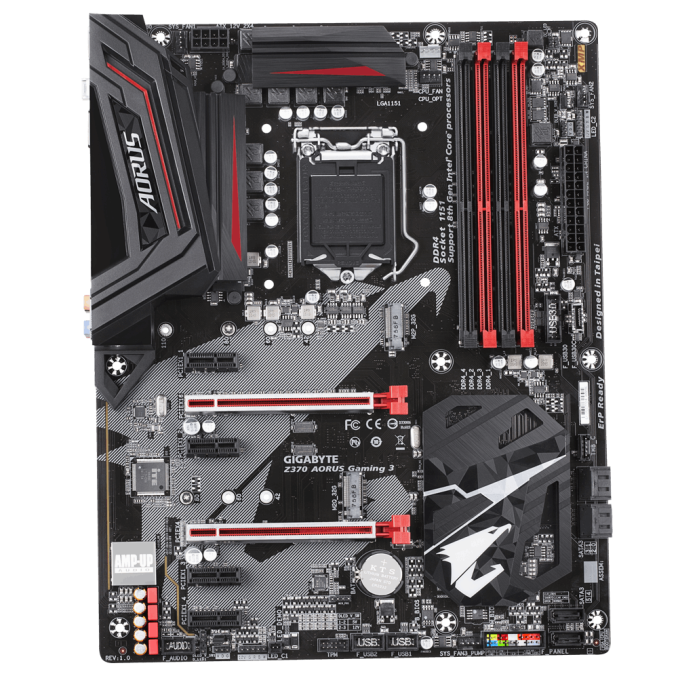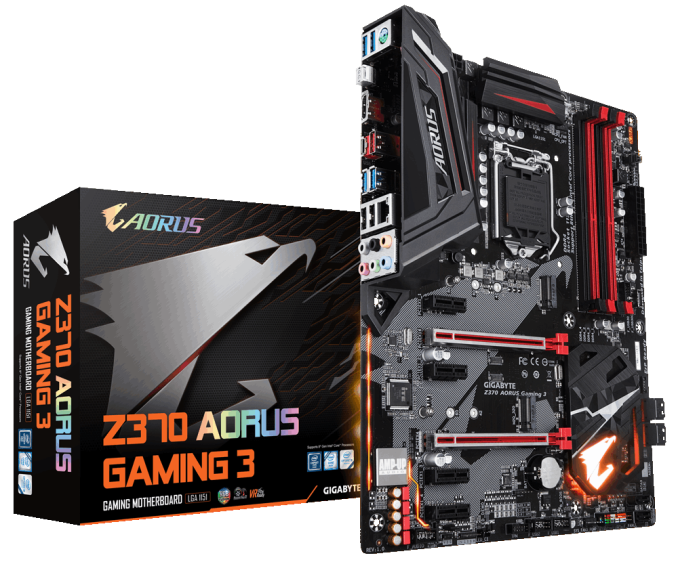Analyzing Z370 for Intel's 8th Generation Coffee Lake: A Quick Look at 50+ Motherboards
by Ian Cutress, Anton Shilov, Joe Shields & Gavin Bonshor on October 20, 2017 2:00 PM ESTGIGABYTE Z370 Gaming 3
The next board is the Z370 AORUS Gaming 3. This board purports to be on the middle of their Gaming series of motherboards and includes RGB Fusion, dual M.2 slots, a Killer E2500 Gaming LAN, the Ultra Durable feature set, and a different color scheme than the other boards in the gaming line.
The Z370 AORUS Gaming 3 uses a black PCB with the AORUS falcon stenciled in through the PCIe area. What is different here compared to some of the other gaming boards is that the reinforced PCIe slots are red instead of black. Instead of all black DIMM slots, two on this board are red; a departure from all black we have seen on the Gaming line previously. The DIMM slots on the Gaming 3 also do not have the strengthened slots. It uses the same chipset heatsink as the Ultra Gaming, and the heatsink is one of two places users will find RGB LEDs on the board. The other location is the audio separation line.
The Gaming 3 uses the platform standard four DIMM slots with speeds up to DDR4-4000 and capacity up to 64GB. The PCIe layout is different on this board compared to what we have looked at previously from GIGABYTE: on this board, there are only two full-length PCIe slots and four PCIe 1x slots. The full-length slots are reinforced (part of their ultra-durable features) and run in an x16/x4 configuration allowing AMD 2-Way Crossfire but not SLI as NVIDIA requires an x8 speed on the slot. That PCIe 3.0 x4 is powered by the chipset, similar to the Z370-P.
For SATA storage, there are six SATA ports, four of which are located on the right side of the board by the PCH, while the other two are found a towards the bottom right-hand corner in a vertical orientation. The two M.2 slots are located just above the top PCIe 1x slot and just above the second full-length PCIe slot. The top slot supports 110mm drives, while the bottom supports up to 80mm.
There are a total of five fan headers on the board. with the CPU and water cooling CPU fan headers by the socket, a system fan by the 8-pin EPS plug, a system fan to the right of the DIMM slots, and the last header is at the bottom of the board. If the lack of RGB LEDs on the board is a turn-off, there are RGBW headers found on the board (one across the bottom, the other by the 24-Pin ATX power connector). Onboard audio is handled by the EMI shielded Realtek ALC1220 codec and like most other gaming boards, uses the Nichicon and WIMA caps. The NIC of choice on this board is the Rivet Networks Killer E2500 and is the only network controller on the board. The Gaming 3 does not include WiFi. Thunderbolt 3 is supported on this board via AIC (Add-In Card).
USB 3.1 (10 Gbps) is handled by an ASMedia 3142 controller and gives us one Type-A and one Type-C adapter both found on the back panel I/O area. From the chipset is another Type-C internal header (5 Gbps), four USB 3.1 (5 Gbps) four ports on the back panel and two more through internal USB headers. There are two USB 2.0 ports on the back panel, and four more through internal USB headers. The remainder of the back panel I/O connectivity consists of a combo PS/2 port, a one-touch overclocking button, an HDMI output for using onboard video, and the audio stack (no SPDIF).
The Gaming 3 finds itself squarely in the middle of the GIGABYTE stack. The mix of features, such as the Killer Gaming NIC, an upgraded audio section, and reinforced slots keep gaming a priority on this board. However, the lack of SLI support will send those with multiple NVIDIA GPUs looking elsewhere.













83 Comments
View All Comments
Aichon - Friday, October 20, 2017 - link
Love this writeup. Thank you guys so much for putting it together so that we can make sense of the choices.peevee - Friday, October 20, 2017 - link
"These motherboards range from $110 "AM4 MBs start from $40 on newegg. Yet another way AMD provides better value.
DigitalFreak - Friday, October 20, 2017 - link
You want a cookie or something?cap87 - Saturday, October 21, 2017 - link
Nobody cares, this a Z370 article. Go back to your cave with the rest of you AMD buddies.imaheadcase - Saturday, October 21, 2017 - link
Apples to oranges.IGTrading - Sunday, October 22, 2017 - link
Very good comment. Not everybody is going to buy a 8700K and thr cheaper CPUs don't really make sense in a 150 USD motherboard.Also, because Intel doesn't guarantee the Boos frequencies anymore, you don't really know what you're going to get with a 8400 for example.
This was very well exemplified here: https://youtu.be/O98qP-FsIWo
psychocipher - Sunday, October 22, 2017 - link
Theres a difference between value and quality. better quality with more features tend to cost more. Dont hate cause amd doesnt get motherboards like the apex. If zen+ increases clock speeds and increases overclocks to where intel is yall will be wishing you didnt buy a cheap $40 b350 motherboard. Yeah you get to keep your cheap b350 motherboard for zen+ but yeah lets buy a new cpu cause amd is providing better value.OFelix - Friday, October 20, 2017 - link
I haven't read the article yet but I want to say that to make sense of 50+ MBs I'm going to need a comparison system which let's me find all MBs with ThunderBolt for example.Brett Howse - Friday, October 20, 2017 - link
Check the last page.Ian Cutress - Friday, October 20, 2017 - link
+1